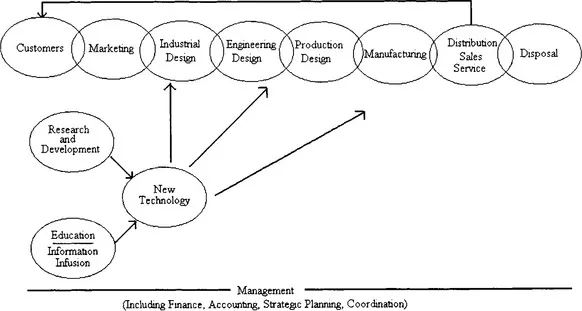
- 424 pages
- English
- ePUB (mobile friendly)
- Available on iOS & Android
About This Book
Design for Manufacturing assists anyone not familiar with various manufacturing processes in better visualizing and understanding the relationship between part design and the ease or difficulty of producing the part.
Decisions made during the early conceptual stages of design have a great effect on subsequent stages. In fact, quite often more than 70% of the manufacturing cost of a product is determined at this conceptual stage, yet manufacturing is not involved. Through this book, designers will gain insight that will allow them to assess the impact of their proposed design on manufacturing difficulty.
The vast majority of components found in commercial batch-manufactured products, such as appliances, computers and office automation equipment are either injection molded, stamped, die cast, or (occasionally) forged. This book emphasizes these particular, most commonly implemented processes.
In addition to chapters on these processes, the book touches upon material process selection, general guidelines for determining whether several components should be combined into a single component or not, communications, the physical and mechanical properties of materials, tolerances, and inspection and quality control.
In developing the DFM methods presented in this book, he has worked with over 30 firms specializing in injection molding, die-casting, forging and stamping.
- Implements a philosophy which allows for easier and more economic production of designs
- Educates designers about manufacturing
- Emphasizes the four major manufacturing processes
Frequently asked questions
Information
Introduction
1.1 MANUFACTURING, DESIGN, AND DESIGN FOR MANUFACTURING
1.2 FUNCTIONAL DESIGNED OBJECTS
Parts
Assemblies and Subassemblies
Products and Machines
1.3 THE PRODUCT REALIZATION PROCESS

Table of contents
- Cover image
- Title page
- Table of Contents
- Copyright
- Dedication
- List of Figures
- List of Tables
- Preface
- Acknowledgments
- Responsibilities of Users
- Chapter 1: Introduction
- Chapter 2: Tolerances, Mechanical Properties, Physical Properties—A Review
- Chapter 3: Polymer Processing
- Chapter 4: Injection Molding: Relative Tooling Cost
- Chapter 5: Injection Molding: Total Relative Part Cost
- Chapter 6: Metal Casting Processes
- Chapter 7: Die Casting: Total Relative Part Cost
- Chapter 8: Sheet-Metal Forming
- Chapter 9: Stamping: Relative Tooling Cost
- Chapter 10: Stamping: Total Relative Part Cost
- Chapter 11: Other Metal Shaping Processes
- Chapter 12: Assembly
- Chapter 13: Selecting Materials and Processes for Special Purpose Parts
- Chapter 14: Communications
- Nomenclature
- Index
- About the CD-ROM